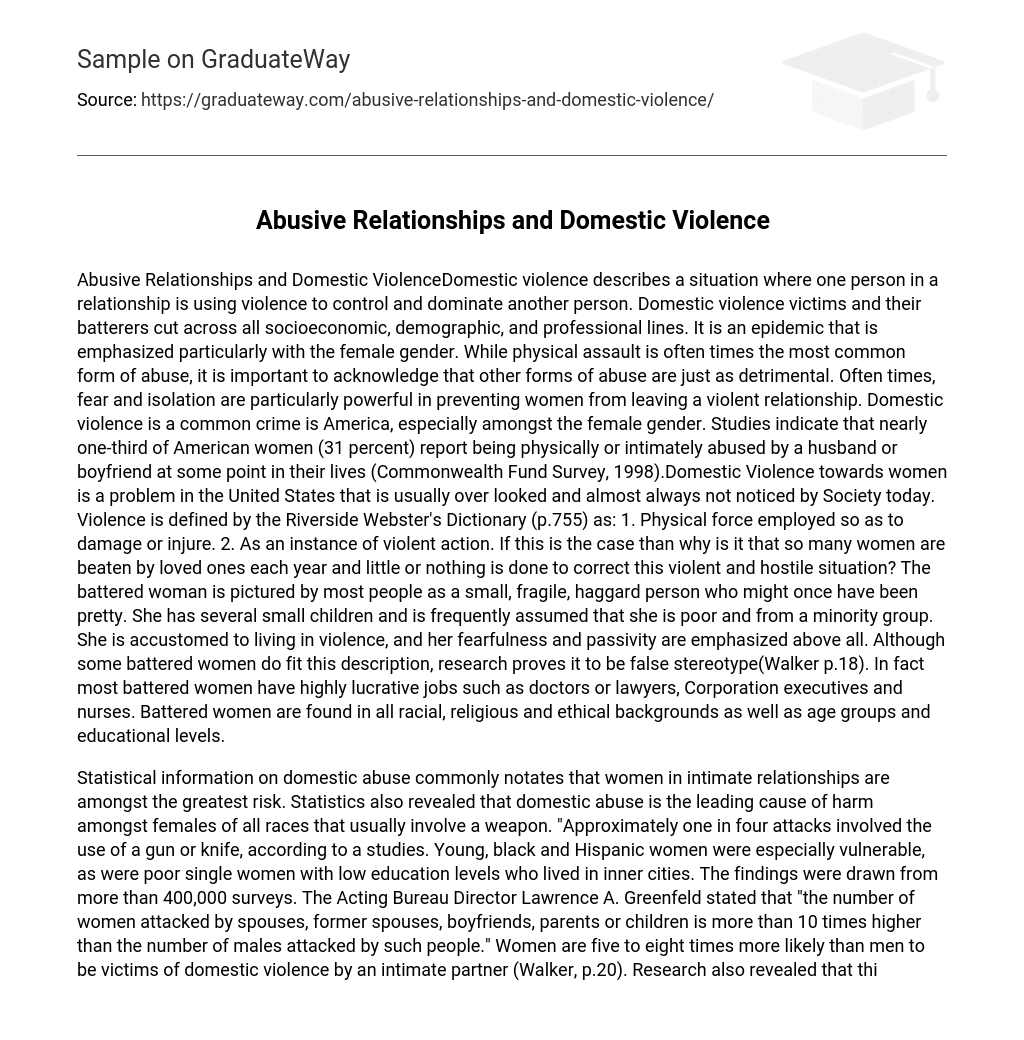Abusive Relationships and Domestic ViolenceDomestic violence describes a situation where one person in a relationship is using violence to control and dominate another person. Domestic violence victims and their batterers cut across all socioeconomic, demographic, and professional lines. It is an epidemic that is emphasized particularly with the female gender. While physical assault is often times the most common form of abuse, it is important to acknowledge that other forms of abuse are just as detrimental. Often times, fear and isolation are particularly powerful in preventing women from leaving a violent relationship. Domestic violence is a common crime is America, especially amongst the female gender. Studies indicate that nearly one-third of American women (31 percent) report being physically or intimately abused by a husband or boyfriend at some point in their lives (Commonwealth Fund Survey, 1998).Domestic Violence towards women is a problem in the United States that is usually over looked and almost always not noticed by Society today. Violence is defined by the Riverside Webster’s Dictionary (p.755) as: 1. Physical force employed so as to damage or injure. 2. As an instance of violent action. If this is the case than why is it that so many women are beaten by loved ones each year and little or nothing is done to correct this violent and hostile situation? The battered woman is pictured by most people as a small, fragile, haggard person who might once have been pretty. She has several small children and is frequently assumed that she is poor and from a minority group. She is accustomed to living in violence, and her fearfulness and passivity are emphasized above all. Although some battered women do fit this description, research proves it to be false stereotype(Walker p.18). In fact most battered women have highly lucrative jobs such as doctors or lawyers, Corporation executives and nurses. Battered women are found in all racial, religious and ethical backgrounds as well as age groups and educational levels.
Statistical information on domestic abuse commonly notates that women in intimate relationships are amongst the greatest risk. Statistics also revealed that domestic abuse is the leading cause of harm amongst females of all races that usually involve a weapon. “Approximately one in four attacks involved the use of a gun or knife, according to a studies. Young, black and Hispanic women were especially vulnerable, as were poor single women with low education levels who lived in inner cities. The findings were drawn from more than 400,000 surveys. The Acting Bureau Director Lawrence A. Greenfeld stated that “the number of women attacked by spouses, former spouses, boyfriends, parents or children is more than 10 times higher than the number of males attacked by such people.” Women are five to eight times more likely than men to be victims of domestic violence by an intimate partner (Walker, p.20). Research also revealed that thirty one percent of American women have reported being physically or sexually abused by a man. Violence by an intimate partner accounts for about twenty one percent of violent crimes experience by women and only about two percent for men(Walker, p25).
Characteristics in numerous categories for both the batterer and battered were the same. Here is a list of those categories that were the same or in a similar fashion the same for both individuals. Commonly shared characteristics between Battered and Batterer. 1. Has low self-esteem. 2. Believes all myths about battering relationships. 3. Is a traditionalist about the home, strongly believes in family unity and his or her roles in the family unit. As with the women all racial, religious, educational levels equally have a problem, although they are aware of it; and they become enraged if their women should reveal the true situation.” (Walker p.36) Other signs of an abusive relationship include physical violence, sexual assault, stalking, and even financial abuse. Why do battered women stay with there significant others? The answer has many different angles; some stay for financial reasons others for the traditional reasons. The fact is that they stay, but when is enough? “After you live so many years, and you wake up one day, and your body has just about had it, you say, ‘My God, I just can’t take another punch.’ That’s what happened to me. I just reached a point where I said, No more. Nothing is worth it.’ I decided I would rather struggle and see if I couldn’t make it, so I just up and left, and that’s been it.” (Langley and Levy p.111) This was the victim of spouse abuse for seventeen years. In another case a women from Maryland described her experience. “Being beaten up is the most degrading, humiliating, crushing kind of thing that could happen to a person.” (Langley and Levy p.116) in most cases the women feel that they are the ones to blame for their battering and also apologize for being beaten. “A women’s decision to stay or go to seek help or suffer in silence is often determined by the frequency of her beatings.”(Langley and Levy p.122). There are methods of getting out of an abusive relationship. There are clinics that specialize in domestic abuse and other abusive situations. Clinics such as The Womens Haven and RAINN are amongst the well known resources for help. There are hotlines and crisis helplines that can help victims and victims have a sense of anonymity.





